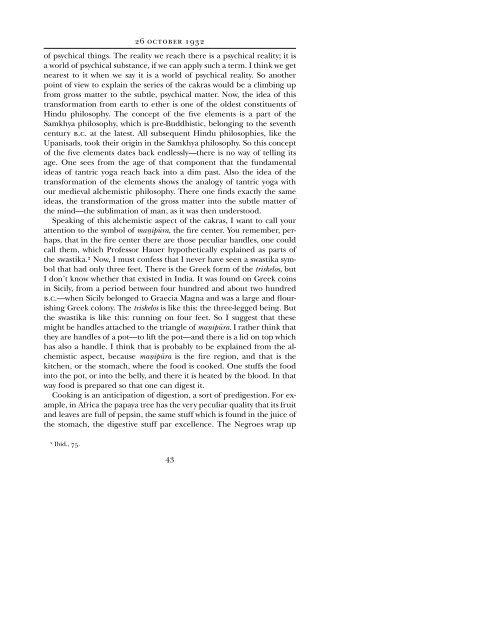CG JUNG - Countryside Anarchist
CG JUNG - Countryside Anarchist
CG JUNG - Countryside Anarchist
You also want an ePaper? Increase the reach of your titles
YUMPU automatically turns print PDFs into web optimized ePapers that Google loves.
26 OCTOBER 1932<br />
of psychical things. The reality we reach there is a psychical reality; it is<br />
a world of psychical substance, if we can apply such a term. I think we get<br />
nearest to it when we say it is a world of psychical reality. So another<br />
point of view to explain the series of the cakras would be a climbing up<br />
from gross matter to the subtle, psychical matter. Now, the idea of this<br />
transformation from earth to ether is one of the oldest constituents of<br />
Hindu philosophy. The concept of the five elements is a part of the<br />
Samkhya philosophy, which is pre-Buddhistic, belonging to the seventh<br />
century B.C. at the latest. All subsequent Hindu philosophies, like the<br />
Upanisads, took their origin in the Samkhya philosophy. So this concept<br />
of the five elements dates back endlessly—there is no way of telling its<br />
age. One sees from the age of that component that the fundamental<br />
ideas of tantric yoga reach back into a dim past. Also the idea of the<br />
transformation of the elements shows the analogy of tantric yoga with<br />
our medieval alchemistic philosophy. There one finds exactly the same<br />
ideas, the transformation of the gross matter into the subtle matter of<br />
the mind—the sublimation of man, as it was then understood.<br />
Speaking of this alchemistic aspect of the cakras, I want to call your<br />
attention to the symbol of maõipÖra, the fire center. You remember, perhaps,<br />
that in the fire center there are those peculiar handles, one could<br />
call them, which Professor Hauer hypothetically explained as parts of<br />
the swastika. 2 Now, I must confess that I never have seen a swastika symbol<br />
that had only three feet. There is the Greek form of the triskelos, but<br />
I don’t know whether that existed in India. It was found on Greek coins<br />
in Sicily, from a period between four hundred and about two hundred<br />
B.C.—when Sicily belonged to Graecia Magna and was a large and flourishing<br />
Greek colony. The triskelos is like this: the three-legged being. But<br />
the swastika is like this: running on four feet. So I suggest that these<br />
might be handles attached to the triangle of maõipÖra. I rather think that<br />
they are handles of a pot—to lift the pot—and there is a lid on top which<br />
has also a handle. I think that is probably to be explained from the alchemistic<br />
aspect, because maõipÖra is the fire region, and that is the<br />
kitchen, or the stomach, where the food is cooked. One stuffs the food<br />
into the pot, or into the belly, and there it is heated by the blood. In that<br />
way food is prepared so that one can digest it.<br />
Cooking is an anticipation of digestion, a sort of predigestion. For example,<br />
in Africa the papaya tree has the very peculiar quality that its fruit<br />
and leaves are full of pepsin, the same stuff which is found in the juice of<br />
the stomach, the digestive stuff par excellence. The Negroes wrap up<br />
2 Ibid., 75.<br />
43


